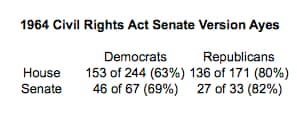Nope and here's why...
by Harry J Enten

Civil rights protestors are attacked with a water cannon.




Civil rights protestors are attacked with a water cannon.
With Republicans having trouble with minorities, some like to point out that the party has a long history of standing up for civil rights compared to Democrats. Democrats, for example, were less likely to vote for the civil rights bills of the 1950s and 1960s.
Democrats were more likely to filibuster. Yet, a closer look at the
voting coalitions suggests a more complicated picture that ultimately
explains why Republicans are not viewed as the party of civil rights.
Let's use the 1964 Civil Rights Act
as our focal point. It was arguably the most important of the many
civil rights bills passed in the middle part of the 20th century. It
outlawed many types of racial and sexual discrimination, including
access to hotels, restaurants, and theaters. In the words of Vice
President Biden, it was a big "f-ing deal".
When we look at the party vote in both houses of Congress, it fits the historical pattern. Republicans are more in favor of the bill:

80% of Republicans in the House and Senate voted for the bill. Less than 70% of Democrats did. Indeed, Minority Leader Republican Everett Dirksen led the fight to end the filibuster. Meanwhile, Democrats such as Richard Russell of Georgia and Strom Thurmond of South Carolina tried as hard as they could to sustain a filibuster. Of course, it was also Democrats who helped usher the bill through
the House, Senate, and ultimately a Democratic president who signed it
into law. The bill wouldn't have passed without the support of Majority
Leader Mike Mansfield of Montana, a Democrat. Majority Whip Hubert Humphrey,
who basically split the Democratic party in two with his 1948
Democratic National Convention speech calling for equal rights for all,
kept tabs on individual members to ensure the bill had the numbers to
overcome the filibuster.
Put another way, party affiliation seems to be somewhat predictive,
but something seems to be missing. So, what factor did best predicting
voting?
You don't need to know too much history to understand that the South
from the civil war to the Civil Rights Act of 1964 tended to be opposed
to minority rights. This factor was separate from party identification
or ideology. We can easily control for this variable by breaking up the
voting by those states that were part of the confederacy and those that
were not.

You can see that geography was far more predictive of voting
coalitions on the Civil Rights than party affiliation. What linked
Dirksen and Mansfield was the fact that they weren't from the south. In
fact, 90% of members of Congress from states (or territories) that were
part of the Union voted in favor of the act, while less than 10% of
members of Congress from the old Confederate states voted for it. This
80pt difference between regions is far greater than the 15pt difference
between parties. But what happens when we control for both party affiliation and region? As Sean Trende noted earlier this year, "sometimes relationships become apparent only after you control for other factors".

In this case, it becomes clear that Democrats in the north and the
south were more likely to vote for the bill than Republicans in the
north and south respectively. This difference in both houses is statistically significant
with over 95% confidence. It just so happened southerners made up a
larger percentage of the Democratic than Republican caucus, which
created the initial impression than Republicans were more in favor of
the act.Nearly
100% of Union state Democrats supported the 1964 Civil Rights Act
compared to 85% of Republicans. None of the southern Republicans voted
for the bill, while a small percentage of southern Democrats did.
The same pattern holds true when looking at ideology instead of party affiliation. The folks over at Voteview.com, who created DW-nominate scores to measure the ideology of congressmen and senators,
found that the more liberal a congressman or senator was the more
likely he would vote for the Civil Rights Act of 1964, once one
controlled for a factor closely linked to geography.
That's why Strom Thurmond left the Democratic party
soon after the Civil Right Act passed. He recognized that of the two
parties, it was the Republican party that was more hospitable to his
message. The Republican candidate for president in 1964, Barry Goldwater, was one of the few non-Confederate state senators to vote against the bill. He carried his home state of Arizona and swept the deep southern states – a first for a Republican ever.
Now, it wasn't that the Civil Rights Act was what turned the South
against the Democrats or minorities against Republicans. Those patterns, as Trende showed,
had been developing for a while. It was, however, a manifestation of
these growing coalitions. The South gradually became home to the
conservative party, while the north became home to the liberal party.
Today, the transformation is nearly complete. President Obama carried
only 18% of former Confederate states, while taking 62% of
non-Confederate states in 2012. Only 27% of southern senators are Democrats, while 62% of Union state senators are Democrats. And 29% of southern members in the House are Democrats compared to 54% in states or territories that were part of the Union.
Thus, it seems to me that minorities have a pretty good idea of what
they are doing when joining the Democratic party. They recognize that
the Democratic party of today looks and sounds a lot more like the
Democratic party of the North that with near unity passed the Civil
Rights Bill of 1964 than the southern Democrats of the era who blocked
it, and today would, like Strom Thurmond, likely be Republicans.

No comments:
Post a Comment